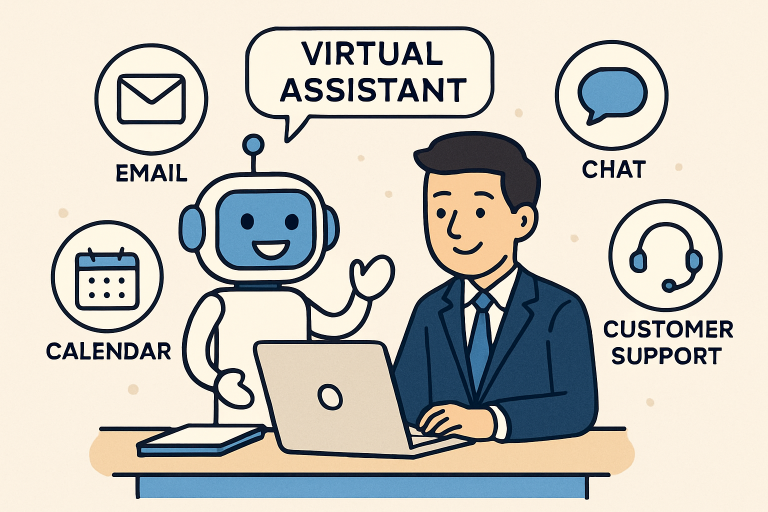In an era defined by digital acceleration and rapidly evolving work environments, organizations worldwide are seeking competitive advantages that optimize efficiency and resource allocation. Among the most influential advancements is the surge in the use of virtual assistants (VAs).
Powered by AI, these adaptable professionals support a wide range of daily operations, helping businesses of all sizes thrive. For companies looking to implement this technology effectively, partnering with a specialized virtual assistant recruiter company can ensure the best match between skills and dynamic operational needs, taking the guesswork out of the hiring process.
The transformation of virtual assistants is not only about improving workflow but also about building a foundation for smarter, leaner, and more customer-focused business practices. Their ability to automate and streamline tasks and integrate seamlessly into existing teams means that organizations can direct their talent and resources to the core initiatives that truly drive growth and innovation.
In my own business, I utilize a virtual assistant to create graphics and schedule social media posts, freeing up time for me to focus on other aspects of the company. What do virtual assistants do to help you grow your small business?
Table of Contents
Boosting Productivity Through Automation
Virtual assistants are a powerful driving force behind productivity gains in traditional workplaces and remote-first organizations, as they take over repetitive and time-intensive duties—such as managing calendars, organizing digital files, and responding to routine emails—freeing employees to concentrate on projects that require analytical or creative skills.
This automation reduces the risk of human error and establishes standardized processes, elevating consistency across workflows. According to a report by Harvard Business Review, organizations using VAs for administrative support often see measurable increases in output and employee satisfaction.
Cost-Effective Solutions for Businesses
Cost control is crucial to operational strategy, particularly for startups and expanding businesses, where every dollar counts. Traditional full-time administrative hires can quickly become a financial burden, with expenses for salaries, benefits, office space, equipment, and ongoing training adding up.
Virtual assistants offer a far more cost-efficient solution, delivering professional support without the overhead associated with permanent staff. They allow companies to access skilled talent on a flexible, as-needed basis, adjusting workload and hours in alignment with seasonal demands or shifting priorities.
This adaptability ensures resources are allocated efficiently, helping organizations remain agile in uncertain markets. By eliminating the need for extensive infrastructure and long-term commitments, businesses can preserve capital for growth initiatives while maintaining high-quality operations.
Ultimately, virtual assistants enable organizations to achieve more with less, optimizing both performance and budgetary efficiency.
Enhancing Customer Service with 24/7 Support by Virtual Assistants
Today’s customers expect fast, accurate responses whenever they reach out—whether by phone, email, chat, or social media. Virtual assistants, primarily those available around the clock, provide prompt support that meets these expectations.
AI-enhanced chatbots can resolve common queries, troubleshoot issues, and escalate complex situations to human team members when necessary.
This approach enhances customer satisfaction and alleviates pressure on frontline employees, enabling them to concentrate on high-value interactions. Studies show that businesses leveraging AI-powered assistants experience improved customer loyalty, as round-the-clock access becomes a new standard for customer service.
For those seeking further insights into emerging trends in AI-driven customer support, McKinsey & Company provides an in-depth overview of the industry’s impacts.

Facilitating Scalability and Flexibility
As organizations evolve, so do their workflow requirements. Busy seasons, abrupt demand spikes, and company expansions can stretch thin the availability of core staff. Virtual assistants offer a seamless solution—additional support can be quickly deployed when needed and scaled back during quieter periods.
This flexibility benefits organizations navigating rapid growth, managing remote teams, or balancing workforces across multiple time zones. By leveraging VAs for scheduling, reminders, database management, and other key tasks, businesses can enhance internal communication and ensure continuity of operations regardless of fluctuations.
Integration of AI in Virtual Assistants
The advancement of artificial intelligence has unlocked sophisticated capabilities for virtual assistants. Modern VAs are adept at collecting, processing, and analyzing substantial data volumes. They can provide real-time insights, generate detailed reports, and surface performance trends that inform strategic decision-making.
For executives and managers, this means access to actionable intelligence that accelerates response to challenges and opportunities. The analytical proficiency of AI-driven assistants boosts competitiveness and enables more proactive and informed leadership across the organization.
Real-World Examples of Virtual Assistant Impact
Many forward-thinking companies are utilizing virtual assistants to revolutionize the way work gets done. For example, global consulting firms deploy VAs to schedule client meetings, track project progress, and manage expense reports, resulting in notable efficiency gains.
Retailers rely on AI chatbots to process thousands of customer interactions daily, offering a personalized experience that traditional teams cannot match at scale. Additionally, remote-first organizations utilize virtual assistants to facilitate collaboration across different time zones, ensuring that everyone remains connected and up to date, regardless of their location.
These organizations’ experiences highlight the transformative value of VAs—not just as productivity tools, but as foundational assets for customer-centric and agile business models. As reported by The Wall Street Journal, the role of VAs will continue to expand as companies integrate intelligent automation into every level of the workplace.
Conclusion: Best Virtual Assistants in 2025
Virtual assistants have evolved from optional helpers to indispensable strategic partners in driving business growth. Their ability to reduce operational costs while significantly boosting productivity makes them invaluable across various industries.
Beyond administrative support, they contribute to delivering exceptional customer service, managing complex projects, and enabling dynamic, scalable operations that adapt to changing demands. Leveraging their expanding skillsets and advanced digital tools, organizations can streamline workflows, enhance efficiency, and free internal teams to focus on innovation.
Businesses that embrace these capabilities gain a competitive advantage, staying agile as market conditions and technologies evolve.
In an era of rapid digital transformation, integrating virtual assistant solutions is not just a smart move—it is a proactive strategy to future-proof operations, optimize resources, and position companies for sustained success in an increasingly competitive global marketplace.




